- An instruction guide is a learner’s translation of teaching procedures, framework, and techniques (Herrington, Oliver, & Reeves, 2012).
- The guide contains effective methods that stimulate and facilitates online and classroom teaching methods (Burrus, McGoldrick, & Schuhmann, 2007).
The factors that facilitate an effective online assessment include
- Learning environment
- Learning style,
- Assessment tools,
- Feedback channel,
- Design application,
- Tools.
- A training audience is the subject group or population that requires the instruction guide (Thaler, Kazemi, & Huscher, 2012).
- Topic: Instruction Manual to Design and Develop an Effective Online Assessment
- Audience: Female teachers in the UAE
- Objectives: To improve teacher’s skill, collaborative skills, design techniques, and effective online strategy that enhances the learner’s performance.
The first slide defines an instructional guide and its features. Please note that an effective classroom technique facilitates learning. Consequently, if we transfer classroom techniques to online platforms using the instruction guide, we will provide an effective assessment tool. Thus, we will categorize the factors that facilitate an effective online assessment tool.
The second challenge after categorizing the features of an instructional design is the audience. We must determine the target audience for the assessment tool. If the target audience is not specific, the instruction design will not be effective. Consequently, the objective of the assessment tool must be ascertained. Why are we conducting the training? Who are we training? What will the trainees benefit from the assessment design?
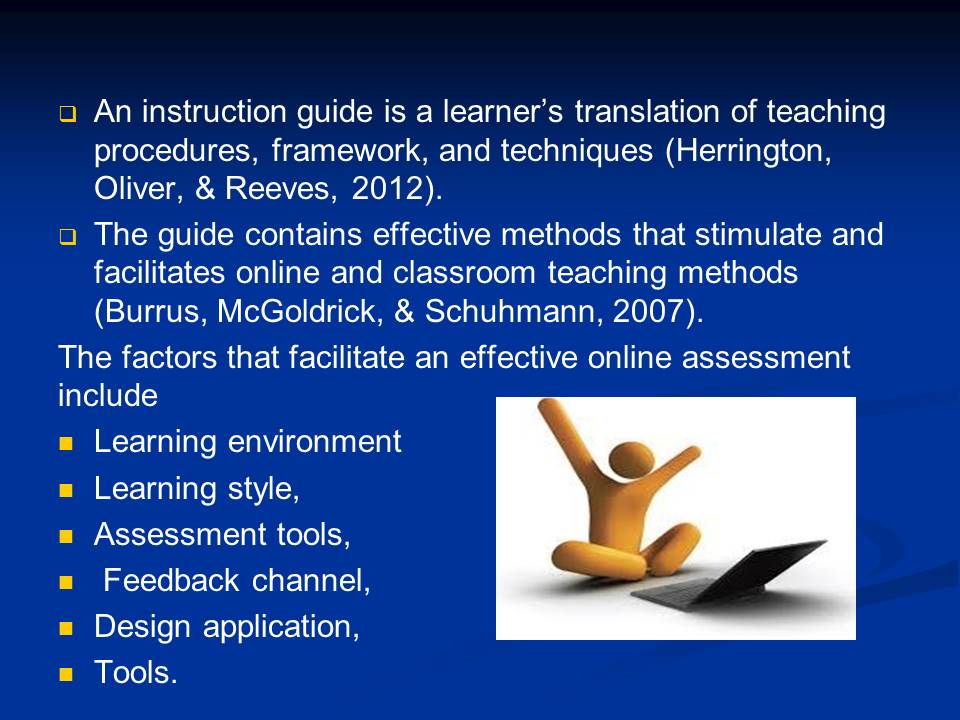
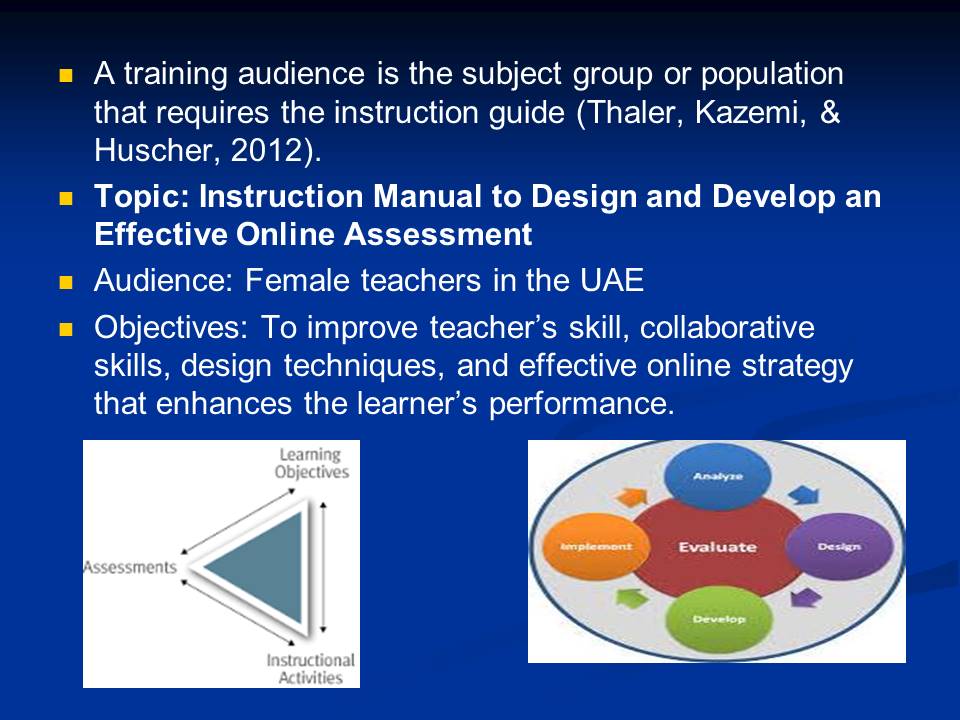
Training modules/units
The training session will be categorized into 8 units, which include :
- Instructional design
- Screen design
- Interface design
- Capability of tool
- User-friendliness
- Impact
- Communication skills
- Team spirit
- The training units will be segmented into three modules, which include training content, assessment tool, and team spirit (Strom & Strom, 2013).
To begin the presentation, we will segment the training sessions into units. The units can be seen in the corresponding slide. Each segment will be analyzed based on the training content.
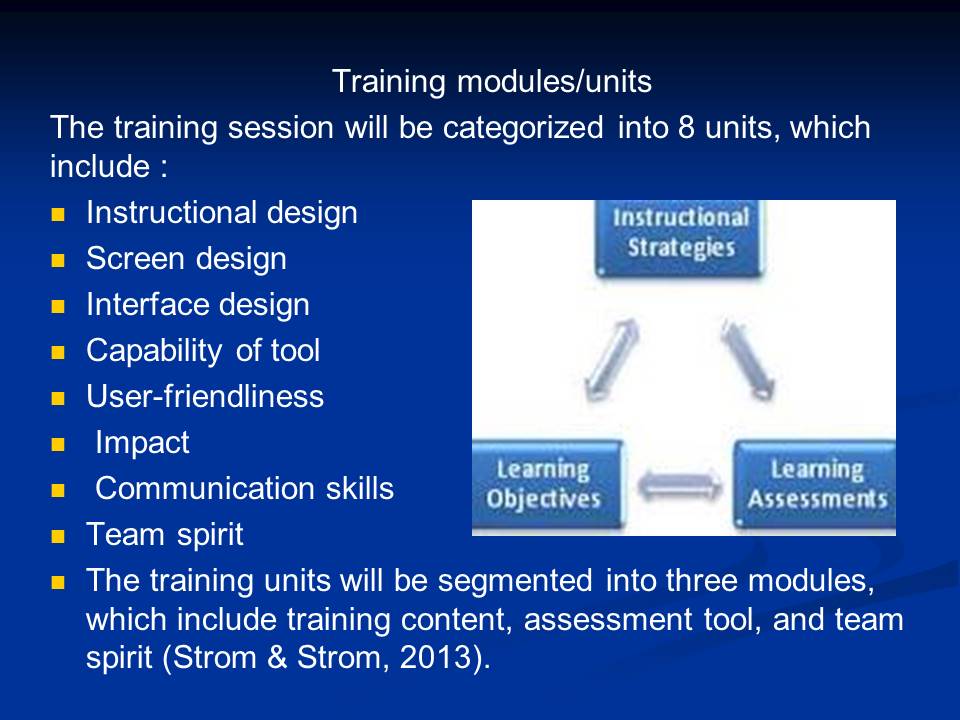
Module 1 will last for 1 hour
- Module objectives: Compare different instructional design based on the learning needs (Krathwohl, 2013).
- Choose an effective instructional design
- Stimulate the learner’s needs with an appropriate screen and interface design (Kayler & Weller, 2007).
- Evaluate the training content
- The trainer will describe with examples the mechanism of an instructional design
- Instructional design for online assessment includes ADDIE model, Merrill’s first principles of instruction, Dick & Carey model, Gagne’s nine events of instruction, Bloom’s learning taxonomy, and the ISD model (Sewell, Frith, & Colvin, 2010).
This slide describes module 1 objective. The participants must evaluate the objectives of each module. Please note that the module objectives must align with the goals of the training. Consequently, the objectives must target specific audience. The training guide will improve teacher’s skill and collaborative effort to design and implement an effective online program.
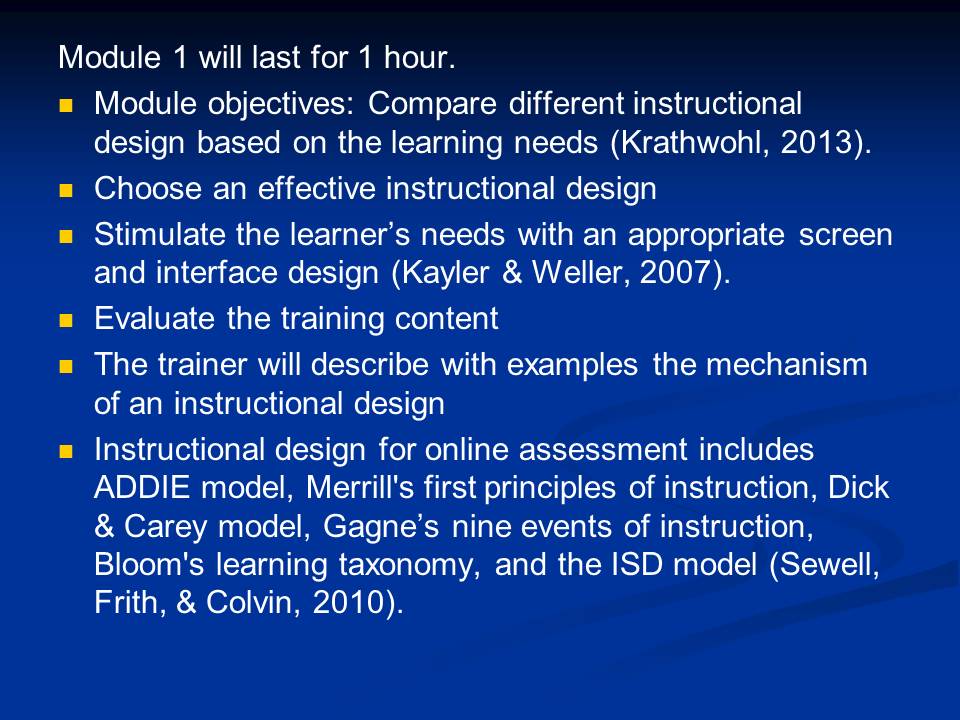
The training will explain the ADDIE model
- The ADDIE model is an instructional design used by educators to organize and present different career training to impact learning.
- The features of the ADDIE model include:
- Analyze
- Design
- Develop
- Implement
- Evaluate.
- The participants will learn about the features of the ADDIE model
- Simple diagrams and charts will be imported to facilitate the training process.
- The session module will end with a workshop drill for the participants.
- Participants at the workshop will develop an assessment-guided question for ADDIE design.
The participants will design the assessment questions for the ADDIE model
- Assessment questions for an effective design tool
- What is the problem statement for the online activity?
- What skill must I transfer to the student?
- What is the least requirement to understand the online activity?
- Assessment questions for the drill workshop(Contd)
- What is the duration of the course contents?
- How many changes are mandatory during the program?
- Can I teach the problem statement online?
- Who identified the learner’s need?
- Why will the student proceed with the assessment?
- What is the period for the assessment?
- What is the limitation of the assessment?
This slide analyzes the features of the ADDIE model. Each feature is defined based on the assessment tool. Therefore, if we consider an online assessment tool for career guide, the features of the ADDIE model must be complementary.
This slide highlights questions that facilitate the ADDIE instructional design. Participants must answer these questions before choosing an implementation strategy. Please note that the best classroom teachers are those that influence knowledge. The choice of instructional design must align with the strategies of learning. This slide continues with the assessment questions for an effective online learning. Participants must answer these questions before formulation the assessment design.
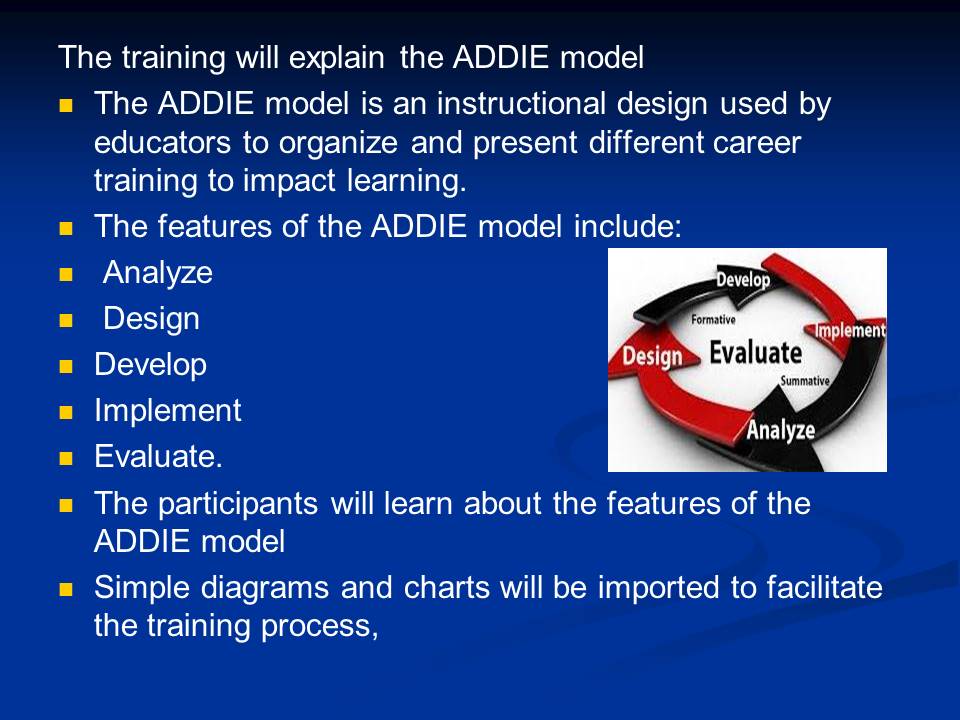
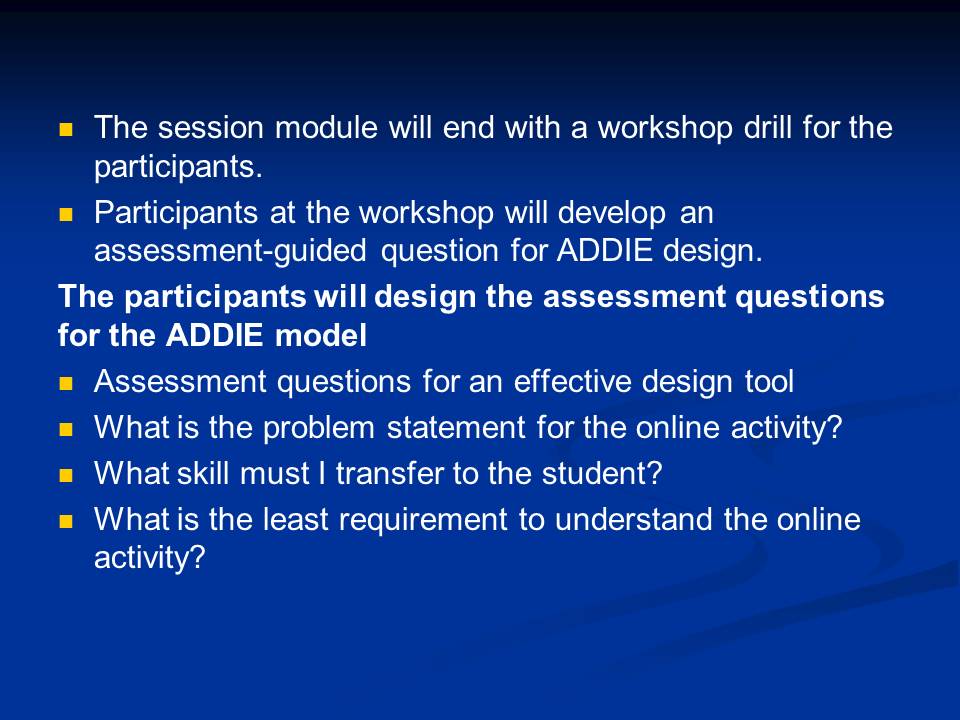
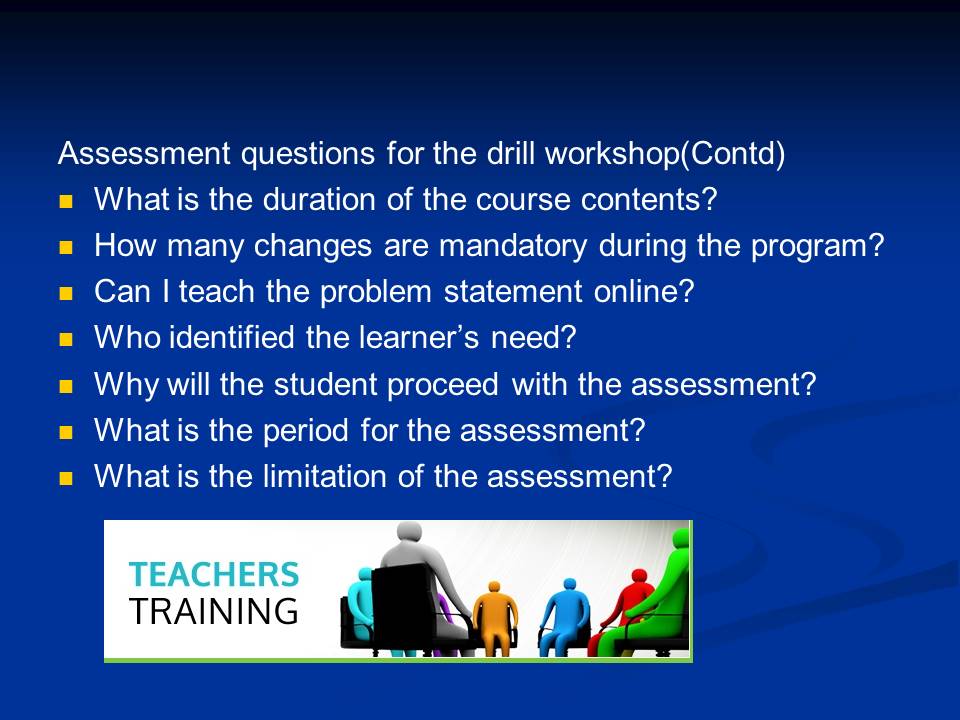
Module 2 objectives
The importance of assessment tools for eLearning.
- Adapt to different learning environment to satisfy the learner’s needs
- Ability to choose an appropriate assessment tool for the target audience
- Ability to evaluate the capability of tools used for online assessment
- The tool must promote and facilitate learning experience
The training session continues with module two. The module objectives highlight the importance of assessment tools for eLearning.
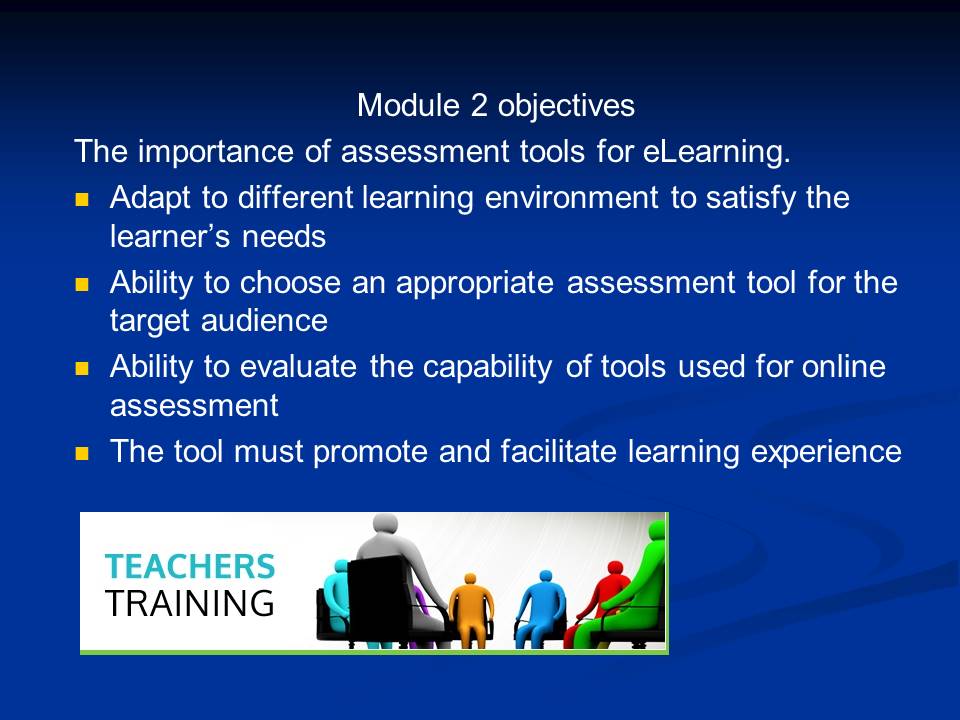
Module 3
- Describe and implement proof of knowledge channel
- The proof of knowledge depends on the assessment technique.
- The assessment tool depends on the desired outcome.
- The teacher must determine the training content, and the proof of knowledge.
Presentation and Team Spirit: Communication Skills
- An effective online assessment tool must have the 4Ps of presentation (Williams, 2012).
- The teacher must explain the components of presentation, which include Plan, Prepare, Practice, and Present (Scardamalia & Bereiter, 2009).
This slide defines communication skills and its channels. Please note that the 3Cs of communication must be implemented to improve learning.
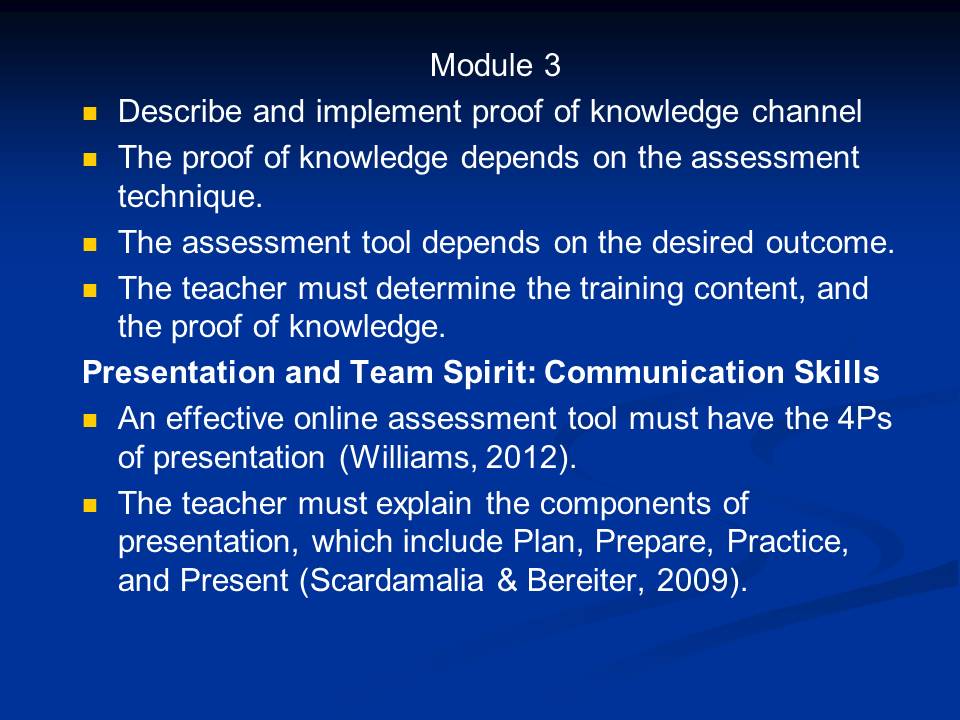
References
Burrus, R. T., McGoldrick, K, & Schuhmenn P. W. (2007). Self-roports of student cheating matter? Journal of Econom ic Education, 38(1), 3-16.
Herrington J., Oliver R. & Reeves, T. (2012). Patterns of engagement in authentic online learning environments. Australian Journal of Educational Technology, 29(4), 59-71.
Kayler. M., & Weller K. (2007). Pedagogy, self-assessment, and online discussion. Education Technology and Society, 10(1), 136-147.
Krathwohl R. (2013). A revision of Bloom’s Taxonomy: An overview. Theory into Practice, 54(7), 212-218.
Scardamalia M., & Bereiter C. (2009). Computer ssuport for knowledge-building communities. The Journal of the Learning Sciences, 7(3), 265-283.
Sewell, J. P., Frith, K. H., & Colvin, M. M. (2010). Online assessment strategies: A primer. MERLOT Journal of Online Learning and Teaching, 6(1), 297-305.
Strom, P. S., & Strom, R. D. (2013). Curbing cheating, raising integrity. Essential Readings Condensed for Quick Review, 72(8), 42-50.
Thaler, N., Kazemi, E., & Huscher, C. (2012). Developing a rubric to assess student learning outcome using a class assignment. Teaching of Psychology, 41(2), 113-116.
Thede, L. Q., & Sewell, J. (2009). Informatics and nursing: Competencies and applications: Lippincott Williams & Wilkins.
Williams, J. (2012). Technology education for teachers. Berlin: Springer Science & Bussiness Media.